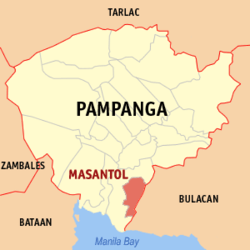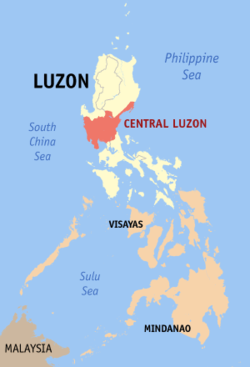Masantol, Pampanga
| Masantol | |
|---|---|
| Municipality | |
|
| |
| Motto: Kayabe Kabang Bie | |
 Map of Pampanga showing the location of Masantol | |
.svg.png) Masantol Location within the Philippines | |
| Coordinates: 14°54′N 120°43′E / 14.900°N 120.717°ECoordinates: 14°54′N 120°43′E / 14.900°N 120.717°E | |
| Country | Philippines |
| Region | Central Luzon (Region III) |
| Province | Pampanga |
| District | 4th District |
| Founded | 1907 |
| Barangays | 26 |
| Government[1] | |
| • Mayor | Danilo Sonza Guintu |
| • Vice Mayor | Rap Nulud |
| Area[2] | |
| • Total | 48.25 km2 (18.63 sq mi) |
| Population (2010)[3] | |
| • Total | 52,407 |
| • Density | 1,100/km2 (2,800/sq mi) |
| Time zone | PST (UTC+8) |
| ZIP code | 2017 |
| Dialing code | 45 |
| Income class | 2nd class |
| Website |
masantolpampanga |
Masantol is a second class municipality in the province of Pampanga, Philippines. According to the 2010 census, it has a population of 52,407 people.[3] The town is named after the santol trees that used to grow abundantly in the area.[4]
Etymology
The town got its name from the fruit tree, either because there was a proliferation of santol trees in the area, or because the town was where santol fruits were heavily bartered (Kapampangans being fond of 'sinigang' dish).
A legend of how the town got its name goes like this: 'A Spanish missionary came to the town for the first time. Upon reaching a roadside corner store, he parked his horse-driven vehicle and inquired from the store keeper the name of the place. A middle-aged woman vendor, believing that the Spanish priest was asking for the name of the fruits she was selling, readily responded in broken Spanish language, Padre, todos dulce Masantol. The priest took from his pocket a pencil and a small diary and wrote down the word mas santol, referring to the name of the place he has visited. At the time, the locality abounded with santol trees, and santol fruits were in season when the priest visited the place.'
History
Tarik Sulayman was an indigenous leader from the Masantol area who refused to ally with the Spaniards and therefore mounted an attack against the Spanish forces of Miguel López de Legazpi during the Battle of Bankusay Channel on June 3, 1571. The Macabebe forces were defeated, and Tarik Sulayman himself was killed. Consequently, this victory enabled the Spaniards to establish themselves throughout the city and its neighboring towns.
Originally named San Miguel de Masantol and a part of the town of Macabebe, three of the town's leading patriarchs - Manuel Fajardo, Gregorio Bautista, and Juan Lacap - filed a motion on June 26, 1877, to separate the barrios of Bebe, Bulacus, Caingin and Nigui from Macabebe thereby creating a new Spanish pueblo called San Miguel. This new pueblo was approved by Spanish Governor General Domingo Moriones y Murillo and was inaugurated on May 1, 1878. On November 30, 1893, the Catholic Parish of San Miguel was formally acknowledged through a Royal Decree.[5] For a while it came to be known San Miguel Masantol, until popular usage reverted it to the original name.
On July 26, 1904, Masantol once more became part of Macabebe. However, in 1907, Masantol was again reinstated as a separate independent municipality and this lasted up to the present.[5]
Tragedy
On January 7, 2008, one person drowned, another missing and 40 others were injured due to electric shocks, when a live cable hit the floating pagoda boat in the fluvial festival of Virgen La Purisima Concepcion at Barangay Alauli.[6]
Barangays
Masantol is politically subdivided into 26 barangays and 2 independent/dependent barrios.
- Alauli
- Bagang
- Balibago
- Bebe Anac
- Bebe Matua
- Bulacus
- San Agustin (Caingin)
- Santa Monica (Caingin)
- Cambasi
- Malauli
- Nigui
- Palimpe
- Puti
- Sagrada (Tibagin)
- San Isidro Anac
- San Isidro Matua (Pob.)
- San Nicolas (Pob.)
- San Pedro
- Santa Cruz
- Santa Lucia Matua
- Santa Lucia Paguiaba
- Santa Lucia Wakas
- Santa Lucia Anac (Pob.)
- Sapang Kawayan
- Sua
- Santo Niño
Barrios:
- Bebe Arabia
- Sagrada 2 (sagrada dos)
Demographics
| Population census of Masantol | ||
|---|---|---|
| Year | Pop. | ±% p.a. |
| 1990 | 41,964 | — |
| 1995 | 45,326 | +1.45% |
| 2000 | 48,120 | +1.29% |
| 2007 | 50,984 | +0.80% |
| 2010 | 52,407 | +1.01% |
| Source: National Statistics Office[3][7] | ||
Religions
The majority of the population are members of the Catholic church and each village or barangay has its own fiesta. The main Roman Catholic parish church of the town is the San Miguel Parish Church in Barangay San Nicolas, established in the late 20th century.
- 95% One Holy Apostolic Catholic Church (Christian) (Roman rite)
- 4% Evangelical, Pentecostal, Presbyterian, Mormons, Protestant etc. (Christian Denomination)
- 0.70% Iglesia Ni Cristo
- 0.20% Islam (Sunni, Shia)
- 0.10% others/non-believers/atheist
Education
Masantol is home to several primary and secondary schools, among them are:
- Bagang Elem. School
- San Miguel Academy Semi-Catholic School (Christian School)
- Holy Child of Mary Academy Semi-Catholic School (Christian School)
- Masantol Elementary School (Masantol Central Elementary School)
- Masantol High School
- Masantol High School Annex in Sagrada (Tarik Suliman High School)
- St. Michael The Archangel Archdiocesan Parochial School Exclusive Catholic School(Masantol Parochial School)
- Pampanga Institute - 1st high school institution in town of Masantol
- Masantol High School Annex -(Malauli High School)
- Caingin Elem. School
- Palimpe Elem. School
- Bebe Anac Elem. School
- Bebe Matua Elem School
- Puti Elem. School
- Sagrada Elem. School
- Sua Elem. School
- San Isidro Elem. School
- Balibago Elem. School
- sta.lucia elem school
- Alauli Elem School
- San Pedro Elem School
- Sta. Cruz Elem School
- San Nicolas Elem School
- Bagang Elem School
- Balibago Elem School
- Niqui Elem School
Festivals
- Batalla San Miguel Arkangel (Apung Migue) - May 8, All Masantolenos
- Viva Sto. Nino - every last Sunday of January. - Brgy. Sto. Nino
- Batalla Santa Monica - May 4. - Brgy. Santa Monica Caingin
- Batalla San Roque de Montpelier (Apung Duque) - August 15,16,17 Barrio Bebe Arabia Brgy. Bebe Anac
- Batalla San Roque (Apung Duque) - 3rd or 4th Sunday of April - Barrio Bebe Centro, Brgy. Bebe Anac
- Batalla San Roque de Montpelier (Apung Duque) - August 15,16,17 Brgy. Bebe Matua
- Fiesta de San Nicolas (Apung Culas) - May 12 and September 10 - Brgy. San Nicolas
- Feast of The HOLY ROSARY - every 2nd Saturday of October in BULACUS MASANTOL
- Batalla de Santa Lucia (Apung Lucia) - December 13 of the year. - Brgy. Santa Lucia Wakas, Matua, Anac
- Batalla de San Agustin (Apung Gustin)- August 28 Brgy. San Agustin Caingin
- Limbun at Libad or Labas Larawan (Celebration of the Saints) in each barrio/barangay celebrating their patron saint for ones a week in January.
Images
- Town hall
- Covered court and 1878 Masantol Monument
- St. Michael the Archangel Parish Church
- Public Market
- Holy Child of Mary College
References
- ↑ "Official City/Municipal 2013 Election Results". Intramuros, Manila, Philippines: Commission on Elections (COMELEC). 1 July 2013. Retrieved 17 September 2013.
- ↑ "Province: Pampanga". PSGC Interactive. Makati City, Philippines: National Statistical Coordination Board. Retrieved 12 December 2012.
- 1 2 3 "Total Population by Province, City, Municipality and Barangay: as of May 1, 2010" (PDF). 2010 Census of Population and Housing. National Statistics Office. Retrieved 12 December 2012.
- ↑ Alejandro S. Camiling. "The Town of Masantol, Pampanga". Historical articles. andropampanga.com. Retrieved 13 December 2012.
- 1 2 "The Town of Masantol, Pampanga". Andropampanga. 2009. Retrieved 2009-08-05. External link in
|publisher=(help) - ↑ chinapost.com.tw, One drowns, 40 injured in Philippine boat mishap
- ↑ "Province of Pampanga". Municipality Population Data. LWUA Research Division. Retrieved 16 August 2013.
External links
| Wikimedia Commons has media related to Masantol, Pampanga. |
- Philippine Standard Geographic Code
- Philippine Census Information
- Local Governance Performance Management System
 |
Macabebe | Calumpit, Bulacan |  | |
| Macabebe | |
Hagonoy, Bulacan | ||
| ||||
| | ||||
| Macabebe |
